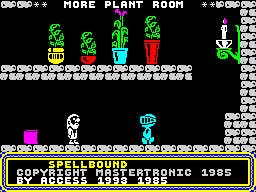Spellbound
A knight to remember.
The second of the Magic Knight titles, Spellbound marked the point at which the series deviated from an action-platformer approach and adopted a more cerebral feel. Before Dizzy had even stretched his eggy legs, David Jones and Ron Hubbard's character was pioneering object-based puzzle shenanigans. They were also among the first developers to release a quality game straight to budget - meaning a price tag of £1.99-2.99, rather than £9.95.
Having given up on pilfering royal treasure, Spellbound's Magic Knight finds himself (or herself, according to the author) interacting with things via a system dubbed "Windimation." This is, in effect, a more rudimentary version of the systems which would later become commonplace in graphical adventures - such as Monkey Island's SCUMM. Through a series of pop-up menus, Magic Knight is able to examine objects, give items to characters, read texts and so on. It's a little clunky in retrospect, but an extremely insightful piece of design.

Using this system, the perpetually-helmeted one must attempt to free himself (or her ... well, you get the idea) and a handful of colleagues from a daunting castle - where they've each been transported by a botched spell. Alongside the adventure aspects, a few arcade moments from Finders Keepers (the first in the series) have been retained. Bouncing balls and strenuous exploration can sap Magic Knight's strength, which must be kept topped up to prevent death from exhaustion. Indeed, one of the earliest conundrums is how to replenish lost energy.
Some of the puzzles can border on obtuse at times, and the potential for sudden deaths - like the hilarious moment where Magic Knight dies from falling over in the dark - can result in some slight aggravation. Nonetheless, Spellbound deserves its accolades for being at the forefront of graphical adventures.
